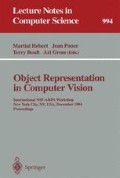Abstract
One of the fundamental problems in representing a curved surface is how to define an intrinsic, i.e., viewer independent, coordinate system over the surface. More precisely, in order to establish point matching between model and observed feature distributions over curved surfaces, we need to set up a coordinate system that maps a point on a curved surface to a point on a standard coordinate system. This mapping should be independent of the viewing direction. Since the boundary of a 3-D object forms a closed surface, a coordinate system defined on the sphere is preferred. We have been exploring several intrinsic mappings from an object surface to a spherical surface. We have investigated several representations including: the EGI (Extended Gaussian Image), the DEGI (Distributed Extended Gaussian Image), the CEGI (Complex Extended Gaussian Image), and the SAI (Spherical Attribute Image). This paper describes each representation and the lessons that we have learned by using those representations in recognition systems.
The research is sponsored in part by National Science Foundation under Grant IRI-9224521, and in part by the Advanced Research Projects Agency under the Army Research Office under Grant DAAH04-94-G-0006.
Preview
Unable to display preview. Download preview PDF.
References
Oshima, M. and Shirai, Y., ”Object recognition using three-dimensional information,” IEEE Trans. Pattern Analysis and Machine Intelligence, PAMI-5,4, July 1983.
Bolles, R.C. and Horaud, P., ”3DPO: A three-dimensional part orientation system,” in Three-Dimensional Machine Vision, Kanade (ed.) Kluwer, Boston, MA, 1987.
Koenderink, J.J. and Van Doorn, A.J., ”The Singularities of the Visual Mapping” ‚,Biological Cybernetics, 24(1), 1976
Chin, R.T. and Dyer, C.R. ”Model-based recognition in robot vision,” ACM Computing Surveys, 18(1), 1986.
Brady, M. Ponce, J., Yuille, A. and Asada, M., ”Describing surfaces,” Robotics Research: 2, Hanafusa, H. and Inoue, H. (eds.), MIT Press, 1985.
Stein, F. and Medioni, G., ”Structural indexing: Efficient 3-D object recognition,” IEEE Trans Pattern Analysis and Machine Intelligence, 14, 2, pp.125–145, February 1992.
Ikeuchi, K., ”Generating an Interpretation Tree from a CAD Model for 3-D Object Recognition in Bin-Picking Tasks,” Intern. Journal of Computer Vision, Vol. 1, Nol. 2, pp.145–165, 1987.
Bowyer, K. W. and Dyer, C. R., ”Aspect graphs: an introduction and survey of recent results,” Inter. Journal of Imaging Systems and Technology, 2, pp.315–328, 1990.
Gauss, K. F., General Investigations of Curved Surfaces, Raven Press, New York, 1965.
Lysternik, L.A., Convex Figures and Polyhedra, Dover Publications, New York, 1963.
Horn, B.K.P., ”Extended Gaussian Image,” Proc. of IEEE, Vol. 72, No. 12, pp.1671–1686, December 1984.
Ikeuchi, K., ”Recognition of 3-D Objects using the Extended Gaussian Image,” Proc. of Intern. Joint Conf on Artificial Intelligence, Vancouver, B.C., pp.595–600, August 1981.
Brou, P., ”Using the Gaussian Image to Find the Orientation of Objects,” Intern. Journal of Robotics Research, Vol. 3, No. 4, pp. 89–125, Winter 1984.
Little, J. J., ”Determining Object Attitude from Extended Gaussian Image,” Proc. of Intern. Joint Conf on Artificial Intelligence, Los Angeles, California, pp. 960–963, August 1985.
Ikeuchi, K. and Horn, B.K.P., ”Picking up an Object from a Pile of Objects,” in Robotics Research: The First International Symposium, J. M. Brady and R. Paul (eds.), MIT Press, Cambridge, Massachusetts, pp. 139–162, 1984.
Kang, S.B. and Ikeuchi, K., ”The Complex EGI: New Representation for 3-D Pose Determination,” IEEE Trans Pattern Analysis and Machine Intelligence, Vol. 15, No. 7, pp. 707–721, July 1993.
Nalwa, V. S., ”Representing Oriented Piecewise C2 Surfaces,” Proc. 2nd Intern. Conf. on Computer Vision, pp. 40–51, December 1988.
Roach, J. W. Wright, J.S., and Ramesh, V., ”Spherical Dual Images: A 3-D Representation Method for Solid Objects that Combines Dual Space and Gaussian Sphere,” Proc. IEEE Conf on Computer Vision and Pattern Recognition, pp. 236–241, June 1986.
Dellingette, H., Hebert, M., and Ikeuchi, K., ”A Spherical Representation for the Recognition of Curved Objects,” Proc. Intern. Conf on Computer Vision, pp.103–112, May 1993.
Besl, P. and Kay, N.D., ”A Method for Registration of 3-D Shapes,” IEEE Trans Patern Analysis Machine Intelligence, Vol. 14, No.2, Feb 1992.
Higuchi, K. Delingette, H. Hebert, M. and Ikeuchi, K., ”Merging Multiple Views using a Spherical Representation,” Proc. IEEE Workshop on CAD-based Vision, pp.124–131, Feb 1993.
Faugeras, O. and Hebert, M., ”The representation, recognition, and locating of 3-D objects,” Intern. Journal of Robotics Research, 5, 3, pp.27–52, 1986.
Author information
Authors and Affiliations
Editor information
Rights and permissions
Copyright information
© 1995 Springer-Verlag Berlin Heidelberg
About this paper
Cite this paper
Ikeuchi, K., Hebert, M. (1995). Spherical representations: From EGI to SAI. In: Hebert, M., Ponce, J., Boult, T., Gross, A. (eds) Object Representation in Computer Vision. ORCV 1994. Lecture Notes in Computer Science, vol 994. Springer, Berlin, Heidelberg. https://doi.org/10.1007/3-540-60477-4_23
Download citation
DOI: https://doi.org/10.1007/3-540-60477-4_23
Published:
Publisher Name: Springer, Berlin, Heidelberg
Print ISBN: 978-3-540-60477-8
Online ISBN: 978-3-540-47526-2
eBook Packages: Springer Book Archive

